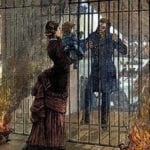 Mysteries
Mysteries  Mysteries
Mysteries  History
History 10 Surprising Stories About the Texas Rangers
 Humans
Humans 10 Philosophers Who Were Driven Mad by Their Own Theories
 Miscellaneous
Miscellaneous 10 Video-Game-Worthy Weapons and Armors from History
 Weird Stuff
Weird Stuff 10 Psychics Who Accurately Predicted Wartime Events
 The Arts
The Arts 10 Pieces of Art Inspired by a Broken Heart
 Health
Health 10 Science Fiction-Sounding New Medical Treatments
 History
History 10 Surprising Facts About the Father of Submarine Warfare
 Space
Space Ten Astonishing New Insights into Alien Worlds
 Weird Stuff
Weird Stuff 10 Bizarre Summer Solstice Rituals Still Practiced Today
 Mysteries
Mysteries Top 10 Haunting Facts About the Ghost Ship MV Alta
 History
History 10 Surprising Stories About the Texas Rangers
 Humans
Humans 10 Philosophers Who Were Driven Mad by Their Own Theories
Who's Behind Listverse?

Jamie Frater
Head Editor
Jamie founded Listverse due to an insatiable desire to share fascinating, obscure, and bizarre facts. He has been a guest speaker on numerous national radio and television stations and is a five time published author.
More About Us Miscellaneous
Miscellaneous 10 Video-Game-Worthy Weapons and Armors from History
 Weird Stuff
Weird Stuff 10 Psychics Who Accurately Predicted Wartime Events
 The Arts
The Arts 10 Pieces of Art Inspired by a Broken Heart
 Health
Health 10 Science Fiction-Sounding New Medical Treatments
 History
History 10 Surprising Facts About the Father of Submarine Warfare
 Space
Space Ten Astonishing New Insights into Alien Worlds
 Weird Stuff
Weird Stuff 10 Bizarre Summer Solstice Rituals Still Practiced Today
Top 10 Fascinating Facts About Lithuania
Wedged between Poland, Belarus and Latvia, the northeastern Europe nation of Lithuania may, at first, seem easy to lump in with its Baltic brethren. And while countries in this formerly Soviet-controlled region certainly have their similarities, Lithuania has a distinct culture and diverse array of customs all its own.
Despite having less than three million residents, Lithuania has a storied history and a modern-day charm. Great food, internationally recognized music and traditions steeped in both paganism and Christianity place it among Europe’s more underrated destinations.
10 Amazing Castles In Europe You’ve Probably Never Heard Of
10 Lithuania Was Once a Superpower
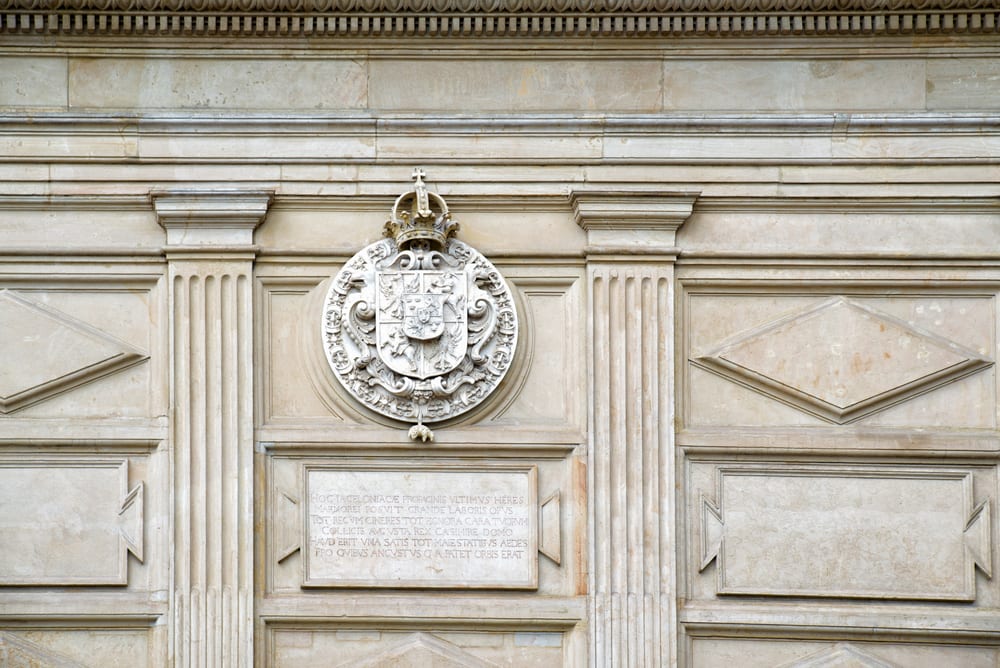
The name “Lithuania” is more than 1,000 years old: written history’s first mention of its Latin form, “Litua,” dates to 1009, in the “Annals of Quedlinburg.” During this time the region was susceptible to both Viking raids and opportunistic taxation by various Danish kings. But by the end of the 14th Century, after a series of military victories brought a sizable portion of modern-day Ukraine under its jurisdiction, Lithuania was among the largest countries in Europe. Its borders, though loose, also branched into present-day Belarus, Poland and Russia.
This confederation became known as the Grand Duchy of Lithuania[1] – which, among other changes, brought about gradual Christianization to one of Europe’s final pagan enclaves. The Poles were a mainstay ally, and 1569 saw the creation of the Polish-Lithuanian Commonwealth, a together-but-separate arrangement where each partner retained a separate army, currency, and statutory laws. The Commonwealth reached its pinnacle in the early 17th Century.
Things then slowly started to crumble. Vilnius, Lithuania’s capital, was sacked and looted by Russia’s army in 1655, and the Great Northern War[2] of 1700-21 took a further toll on both blood and treasure. Crushingly, plague and famine then killed off roughly 40% of the population.
In a last ditch effort to save its sovereignty, the Polish-Lithuanian Commonwealth’s joint Sejm, or Parliament, adopted a Constitution in 1791,[3] patterned after the recently ratified United State Constitution. It didn’t work. By 1795, the Commonwealth’s territory had been partitioned among Russia, Prussia and the Austria-centric Habsburg Monarchy. Most of Lithuania came under Russian control.
9 So Nice They Freed It Twice
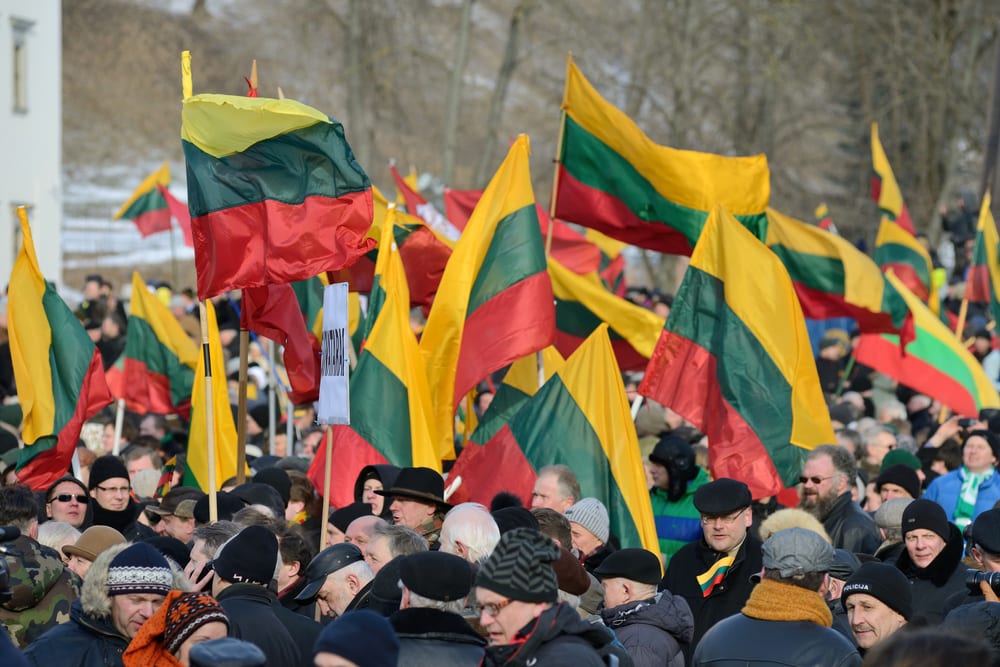
Reflecting both its tumultuous past and proud present, Lithuania has two national holidays celebrating its autonomy.[4] First, February 16 marks Restoration of the State Day, which commemorates one of history’s best “none of the above” multiple choice answers.
Though an independent country since the 13th Century, in 1795 the Russian Empire took control of Lithuania,[5] an imposed rule that lasted until German troops occupied the region during World War I. Neither country – Germany due to its teetering war machine and Russia due to its 1917 revolution – was in an optimal position to lord over Lithuania. So when pressed by both parties, Lithuania chose… neither, thank you very much. They declared themselves free while two would-be oppressors tended to higher priorities.
That worked until 1940, when Soviet forces fighting Hitler occupied Lithuania. The Nazis drove the Red Army out for some time, but by 1944 the caught-in-the-middle country was back in Soviet hands. It remained behind the USSR’s Iron Curtain until the bloc’s death throes began in 1989. Lithuania officially declared its severance from Soviet Russia on March 11, 1990, now known as Restoration of Independence Day.[6]
Both independence days are marked with the closure of businesses, as well as banners, flags and garb showcasing the country’s national colors: yellow, green and red.
8 The Longest Peaceful Protest Ever

And by longest, we mean lengthiest – as in nearly 700 kilometers of fed-up freedom seekers.
August 23, 1989 marked the 50th anniversary of the Molotov-Ribbentrop Pact, the 1939 non-aggression agreement between Hitler’s Germany and Stalin’s Soviet Union. Though Germany soon violated the pact by invading Russia, the treaty included a not-so-clandestine agreement – loosely called the Secret Protocol[7] – that defined the borders of Soviet and German spheres of influence across Lithuania, Latvia and Estonia, among other regional nations. While Hitler’s Third Reich would be kaput just six years later, the aforementioned countries remained Russian satellites – non self-determining spoils of war.
The USSR held firm for decades, then crumbled rapidly. Three months before the Berlin Wall fell, more than two million residents of the so-called Baltic states – including one million in Lithuania alone—clasped hands in a united call for individual independence. In what became known as the Baltic Way,[8] a human line stretched 675 kilometers from Tallinn, Estonia to the Lithuanian capital city of Vilnius.
Rather than deny the undeniable, the USSR responded to the damning international publicity by both acknowledging the Secret Protocol’s existence and declaring it invalid. This was a pivotal step toward renewing independence to Lithuania and her sister Baltic nations.
7 Lithuanians Traditions Blend Christianity and Paganism

Many of Lithuania’s traditions combine customs of ancient Baltic pagans with Christianity. The results are unique blends that gradually introduce new wrinkles while retaining core elements of deep-rooted national identity.
One such endearing cultural mashup comes on Christmas Eve, which Lithuanians call Kucios.[9] Lithuanians await the birth of Jesus with a nod to their society’s agricultural and pagan roots. Customs include tasting each of 12 meatless dishes to ensure a fulfilling, successful year to follow, and leaving out a plate of food overnight for deceased loved ones. Interestingly, Lithuanians believe Christ’s birth was so miraculous that the well water turned to wine, and the animals in the barn were moved to speech;[10] in honor of these anthropomorphized animals, pets are often fed human food during Kucios festivities.
Lithuanians also have a charming way of welcoming summer. Ancient Lithuanians believed that, at midnight on June 23, witches gathered and flew off to the hills of Šatrija or Rambynas to celebrate. So on this night – deemed the shortest night of the year despite being a day or two after the official summer solstice – Lithuanians light bonfires to chase away witches and other evil spirits.
During this pagan-derived annual tradition, called Jonines,[11] revelers search for a mythological blooming fern that wields magical powers, and anyone who bathes in the next morning’s dew is ensured health for the remainder of the year. Jonines festivities are most spectacular and authentic at the Kernave archeological site near Vilnius.
6 Its Language is Among the World’s Oldest
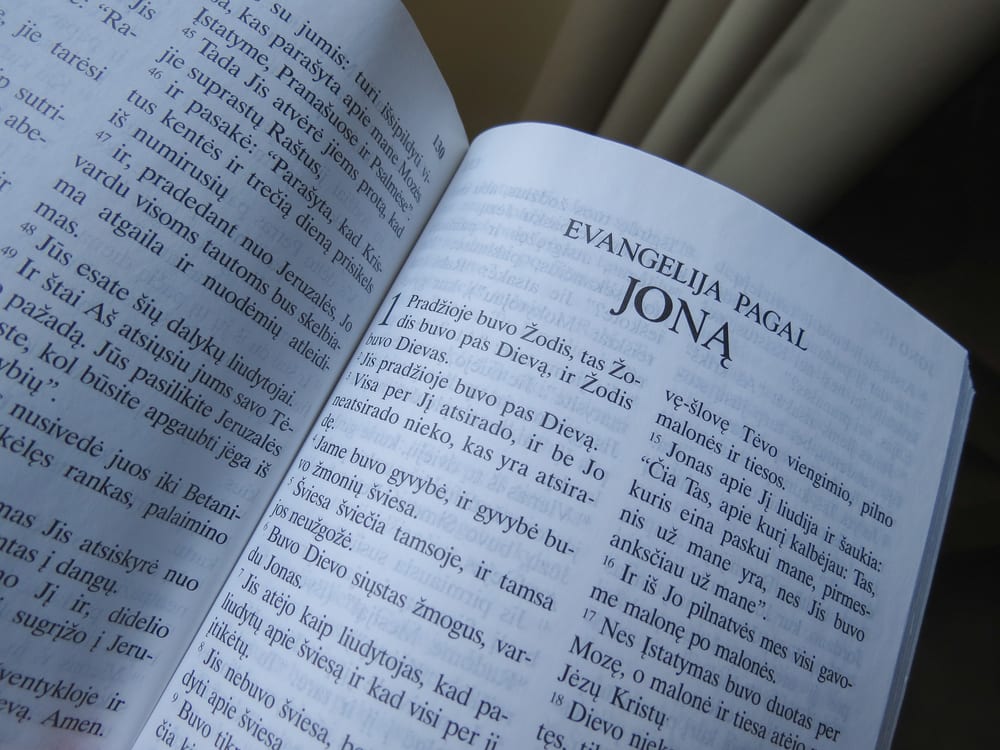
Most European tongues belong to the Indo-European language family,[12] but these two influences started diverging around 3500 BC. This regional branching effect helped give rise to dozens of other languages including German, Italian and English; while certainly retaining some similarities, these “offspring” languages gradually lost many of the common lingual features they once shared.
For whatever reason, Lithuanian did not follow this derivative, divergent path, instead retaining an outsized portion of features linguists call Proto-Indo-European (PIE) – the language most believe was spoken around 3500 BC. Perhaps due to the Baltic’s relative isolation five-plus millennia ago, Lithuanian has kept more of the sounds and grammar rules from PIE than any of its linguistic cousins, and can therefore be called one of the world’s oldest languages.
Notably, Lithuanian retains a decided influence from ancient Sanskrit.[13] As languages go it is considered one of the more difficult to learn, as evidenced by a 37-letter word, “Nebeprisikiškiakopusteliaudamas”,[14] which roughly translates to “a group of people who used to go to a forest to pick up some rabbit grass, but are no longer doing that.” How useful.
10 Unusual Festivals Around The World
5 Lithuanian Kids Anxiously Await the Easter… Granny?

You know what makes more sense than a bunny – a non-confectionary-associated, non-egg-laying mammal – bringing kids dyed eggs and chocolates on the holiest day on the Christian calendar? Pretty much anything at all.
In Lithuania, the responsibility of hiding pastel eggs and giving children cavities falls to Velyku Bobute, the Easter Granny. Children often prepare for good ol’ Bobute by leaving empty homemade egg nests outside their homes in gardens and shrubs. According to legend, the Easter Granny has a cart pulled by a pony and a sunbeam whip to encourage its haste, which may or may not have fictional animal rights activists up in arms.
Granny works smart, not hard. She has helpers – you guessed it, bunnies – that dye the eggs and load the cart for her. She then embarks on her annual sojourn, delivering eggs and candies overnight while the little ones sleep. Not surprisingly, Velyku Bobute is often imitated by actual grandmothers,[15] who dress up to their grandchildren’s delight.
Lithuania has another charming Easter tradition as well: housecall choir singing.[16] Similar to Christmas caroling, festive Lithuanians sing hymns in exchange for decorated eggs, candies or other goodies. All totaled, it seems obvious that Lithuanians Easter better than the vast majority of us.
4 A Rich Tradition of Folk Music
Before modernity, Lithuanians were accustomed to singing throughout the day – creating their own soundtrack to daily life. Some of Lithuania’s oldest ditties describe surprisingly specific tasks, such as sowing, while others celebrated more universally recognizable events like harvests, weddings and departing for war.
The lyrics of old (pre-19th Century) Lithuanian folk songs are full of diminutives. Some songs, known as sutartines,[17] are multipart. Sung by two to four persons, these have few counterparts in Europe, and are aptly recognized on UNESCO’s roster of Intangible Cultural Heritage of Humanity.[18]
To this day Lithuania is home to a variety of folk music festivals, the most prominent being the state-supported Dainu švente (literally “Song Festival”), which was first held in 1924. The Baltica International Folklore Festival, which celebrates the folk music and cultures of all Baltic nations, is held in one of the Baltic states every year.
Per Lithuanians’ penchant for blending the old and the new, in recent year years a subgenre has gained traction: folk rock. Above is a highly entertaining example with English subtitles.
3 Lithuania Has a National Scent

Every country has national symbols – points of pride and distinction intended to evoke patriotism, nostalgia or reverence. The United States has had an official bird, the bald Eagle, since 1782 – just one year after the American Revolutionary War was decided. The tulip is recognized around the world as an endearing symbol of The Netherlands, while Canada’s maple leaf pays homage to its prized homegrown export, maple syrup, a sap on tap well before Europeans arrived.[19]
Lithuania, however, is likely unique among nations in having a national scent.[20] Developed by well-regarded perfumer Galimard, “Lietuvos Kvapas,” which translates roughly to “The Scent of Lithuania,” is a blend of bergamot, wild flowers, ginger, raspberry and grapefruit, with base notes of amber, cedar, sandalwood, patchouli and, somewhat oddly, tree moss and smoke.
Though admittedly a marketing gimmick to bolster Lithuania’s appeal to tourists, there is sound science behind the scent. It is well-recognized that pleasant aromas evoke nostalgia and longing, making someone who catches a whiff of Lietuvos Kvapas in London more likely to hop a plane to Vilnius. The perfume even has a matching scented candle. You stay classy, Lithuania.
2 Inventions: From the Delicious to the Deadly
Several highly useful inventions were devised by Lithuanians. One is the non-invasive cranial pressure meter[21] – which, one would imagine, is a vast improvement over measuring one’s cranial pressure invasively. Another Lithuanian, Gasparas Kazlauskas,[22] invented the orbital tube welding head, which allows metalworkers to create symmetrically perfect circles. Without the orbital tube welding head it would have been impossible to create, among other innovations, the radioisotope thermoelectric generators utilized on NASA’s Apollo missions throughout the 1970s.
A Lithuanian also invented one of the world’s most wonderful sandwiches. Well, maybe. The reuben, comprising corned beef, Swiss cheese, sauerkraut, and Russian dressing between grilled slices of rye bread, has been tantalizing taste buds and clogging arteries for about a century. While New York delicatessen owner Arnold Reuben claims to have invented the concoction around 1914, Lithuanian-born Reuben Kulakofsky declares the bellybuster his own brainchild.
Less disputable is Lithuania’s wildest and most macabre invention: the Euthanasia rollercoaster. In 2010, Julijonas Urbonas became the first person in the world to design (or even consider) a hypothetical rollercoaster that chills, thrills, and finally kills all passengers. The idea is a quick, euphoric death by G-force-driven cerebral hypoxia. Urbonas envisions the conceptualized contraption as having 24 seats; it’s unclear whether group rates will be available.
1 Lithuanian Cuisine: Simple Yet Satisfying
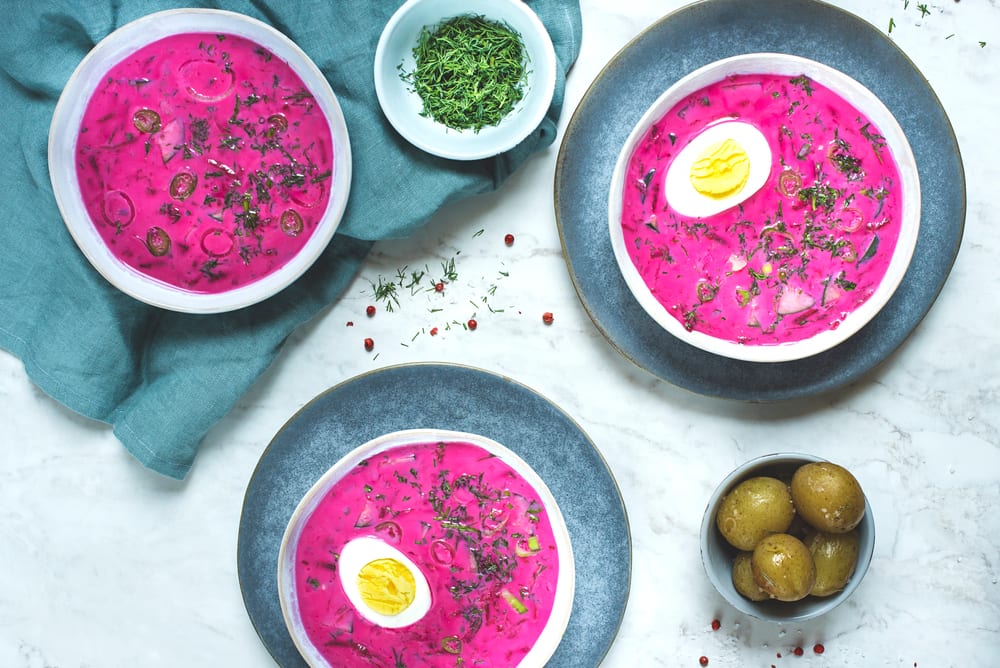
Like its Eastern European neighbors, Lithuania features a meat-and-potatoes type cuisine that, while not being particularly intricate, is inviting in its hominess. Most of the country’s go-to dishes feature foodstuffs suited to the cool, moist Baltic climate, such as barley, potatoes, rye, beets, greens, berries, and various mushrooms.
You’d expect a country that borders Poland to have its own take on pierogies, and you’d be right. Lithuania’s national dish, cepelinai,[23] are large potato-dough dumplings stuffed with pork and doused in sour cream and bacon sauce (yes please). Beetroot soup – basically warm, wonderful borscht – is a pre-meal regular, as is rye bread fried in oil. A particularly interesting offering is kibinai,[24] soft-crusted hand pies filled with meat, veggies, cheese curd and berry jams. Sweet and sumptuous, kibinai are tied to Lithuania’s well-established population of Kariates, an ethnic Turkic group.
Lithuanians also eat crow. Literally.[25] A squawking shunned nuisance in most countries, the wild crow is popular in Lithuania for its tender meat. Young crows caught before leaving the nest are considered a particular delicacy, and apparently have a taste similar to quail.
10 Recent Discoveries Concerning Ancient Europe






